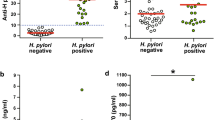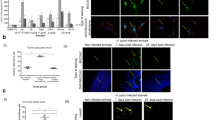Abstract
Helicobacter pylori infection is associated with gastric mucosal damage and the infiltration of neutrophils. Myeloperoxidase from neutrophils produces hypochlorous acid, which yields monochloramine in the presence of ammonia produced by urease enzyme ofHelicobacter pylori. The target cells of gastric mucosal damage are gastric mucosal cells and endothelial cells. We therefore tested the hypothesis that ammonium, hypochlorous acid, and monochloramine damage the target cells. We studied thein vitro cytotoxic effects of ammonium chloride, sodium hypochlorite, monochloramine, and activated neutrophils on the target cells. Cytotoxicity was measured by a51Cr-release assay. Ammonium chloride, sodium hypochlorite, and monochloramine were toxic to labeled cells in a concentration dependent manner. The toxicity of these agents was in the order monochloramine>sodium hypochlorite>>ammonium chloride. Incubation of labeled cells with activated neutrophils,Helicobacter pylori, and urea resulted in cytolysis. These cytotoxicities were significantly inhibited by the scavenger of hypochlorous acid, taurine. Monochloramine is more toxic to the target cells than ammonium chloride. Although ammonium chloride at neutral pH by itself has little direct damaging effect on the gastric mucosa, it is damaging to the gastric mucosa through a reaction with hypochlorous acid, suggesting that it plays a role inHelicobacter pylori-associated gastric damage.
Similar content being viewed by others
References
Marshall BJ, Warren JR: Unidentified curved bacilli in the stomach of patients with gastritis and peptic ulceration. Lancet 1:1311–1315, 1984
Goodwin CS, Armstrong JA, Marshall BJ:Campylobacter pyloridis, gastritis, and peptic ulceration. J Clin Pathol 39:353–355, 1986
Langenberg ML, Tytgat GNJ, Schipper MEI, Rietra PJGM, Zangen HC:Campylobacter pylori infection in the stomach of patients and healthy individuals. Lancet 1:1348–1349, 1984
Rathbone BJ, Wyatt JI, Worsley BW, Trejdosiewicz LK, Heatley RV, Losowsky MS: Immune response toCampylobacter pyloridis. Lancet 1:1217, 1985
Hazell SL, Lee A, Brady L, Hennessy W:Campylobacter pyloridis and gastritis: Association with intracellular spaces and adaption to an environment of mucous as important factors in colonization of the gastric epithelium. J Infect Dis 153:658–663, 1986
Tricottet V, Bruneval P, Vire O, Camilleri JP, Bloch F, Bonte N, Roge J:Campylobacter-like organisms and surface epithelium abnormalities in active, chronic gastritis in humans: An ultrastructural study. Ultrastruct Pathol 10:113–122, 1986
Grisham MB, Jefferson MM, Thomas EL: Role of monochloramine in the oxidation of erythrocyte hemoglobin by stimulated neutrophils. J Biol Chem 259:6757–6765, 1984
Thomas EL, Grisham MB, Melton DF, Jefferson MM: Evidence for a role of Taurine in thein vitro oxidative toxicity of neutrophils toward erythrocytes. J Biol Chem 260:3321–3329, 1985
Klebanoff SJ, Clark RA: The Neutrophil: Function and Clinical Disorders. Amsterdam, North Holland Publishing, 1978
Babior BM: Oxygen-dependent microbial killing by phagocytes. N Engl J Med 298:659–668, 1978
Badwey JA, Karnovsky ML: Active oxygen species and the functions of phagocytic leukocytes. Annu Rev Biochem 49:695–726, 1980
Klebanoff SJ: Oxigen metabolism and the toxic properties of phagocytes. Ann Intern Med 93:480–489, 1980
Weiss SJ, Young J, LoBuglio AF, Slivka A: Role of hydrogen peroxide in neutrophil-mediated destruction of cultured endothelial cells. J Clin Invest 68:714–721, 1981
Weiss SJ, Slivka A: Monocyte and granulocyte-mediated tumor cell destruction: A role for the hydrogen peroxide-myeloper-oxidase-chloride system. J Clin Invest 69:255–262, 1982
Saita H, Murakami M, Teramura S, Dekigai H, Kusaka S, Asagoe K, Kita T:Helicobacter pylori has an ulcerogenic action in the ischemic stomach of rats. J Clin Gastroenterol 14(suppl 1):s122-s126, 1992
Szabo S, Nagy L, Morales RE, Sandor ZS: Ammonia is more damaging to the gastric mucosa than ethanol: Role of sulfhydryls and vascular injury. Gastroenterology 102:A703, 1992 (abstract)
Terano A, Ivey KJ, Stachura J, Sekhon S, Hosojima H, Mckenzie WN, Krause WJ, Wyche JH: Cell culture of rat gastric fundic mucosa. Gastroenterology 83:1280–1291, 1982
Del Vecchio PJ, Smith JR: Expression of angiotensin-converting enzyme in cultured pulmonary artery endothelial cells. J Cell Physiol 108:337–345, 1981
Weiss SJ, Klein R, Slivka A, Wei M: Chlorination of taurine by human neutrophils. Evidence for hypochlorous acid generation. J Clin Invest 70:598–607, 1982
Thomas EL, Grisham MB, Jefferson MM: Myeloperoxidase-dependent effect of amines on functions of isolated neutrophils. J Clin Invest 72:441–454, 1983
Phillips HJ: Dye exclusion tests for cell viability.In Tissue Culture Methods and Application. PF Krause, MK Patterson (eds). New York, Academic Press, 1973, pp 406–408
Leunk RD, Johnson PT, David BC, Kraft WG, Morgan DR: Cytotoxic activity in broth-culture filtrates ofCampylobacter pylori. J Med Microbiol 26:93–99, 1988
Sarosiek J, Slomiany A, Slomiany BL: Evidence for weakening of gastric mucus integrity byCampylobacter pylori. Scand J Gastroenterol 23:585–590, 1988
Slomiany BL, Kasinathan C, Slomiany A: Lipolytic activity ofCampylobacter pylori: Effect of colloidal bismuth subcitrate (De-Nol). Am J Gastroenterol 84:1273–1277, 1989
Hazell SL, Lee A:Campylobacter pyloridis, urease, hydrogen ion diffusion, and gastric ulcers. Lancet 2:15–17, 1986
Marshall BJ, Barrett LT, Prakash C, McCallum RW, Gurerrat RL: Urea protectsHelicobacter (Campylobacter)pylori from the bactericidal effect of acid. Gastroenterology 99:697–702, 1990
Marshall BJ, Langton SR: Urea hydrolysis of patients withCampylobacter pyloidis infection. Lancet 1:965–956, 1986
Murakami M, Yoo JK, Mizuno M, Saita H: Effects of ammonia, urea, and urease on the rat gastric mucosa. Gastroenterology 97:1544, 1987 (abstract)
Murakami M, Yoo JK, Inada M, Miyake T: Effect of ammonia on the gastric mucosa in rats: Pathophysiological importance of urease in gastric ulcer disease. Jpn J Pharmacol 47:330–332, 1988
Seiki M, Murakami M, Yoo JK: Effects of ammonia on the gastric mucosal barrier in rats and dogs. Jpn J Pharmacol 51:143–145, 1989
Murakami M, Yoo JK, Teramura S, Yamamoto K, Saita H, Kita T: Protective effect of taurine against ammonia-induced gastric mucosal lesions in rats. Jpn J Pharmacol 51:569–571, 1989
Murakami M, Saita H, Teramura S, Dekigai H, Asagoe K, Kusaka S, Kita T: Gastric ammonia has a potent ulcerogenic action on the rat stomach. Gastroenterology 105:1710–1715. 1993
Murakami M, Asagoe K, Dekigai H, Kusaka S, Saita H, Kita T: Products of neutrophil metabolism increase ammonia-induced gastric mucosal damage. Dig Dis Sci 40:268–273, 1994
Szabo S, Trier JS, Brown A, Schnoor J: Early vascular injury and increased vascular permeability in gastric mucosal injury caused by ethanol in the rat. Gastroenterology 88:228–236, 1985
Kozol R, Kopatsis A, Fligiel SEG, Czanko R, Callewaert D: Neutrophil-mediated injury to gastric mucosal surface cells. Dig Dis Sci 39:138–144, 1994
Suzuki M, Miura S, Suematu M, Fukumura D, Kurose I, Suzuki H, Kai A, Kudoh Y, Ohashi M, Tuchiya M:Helicobacter pylori-associated ammonia production enhances neutrophil-dependent gastric mucosal cell injury. Am J Physiol 263:G719-G725, 1992
Mooney C, Keenan J, Munster D, Wilson I, Allardyce R, Bagshaw P: Neutrophil activation byHelicobacter pylori. Gut 32:853–857, 1991
Niesen H, Andersen LP: Activation of human phagocyte oxidative metabolism byHelicobacter pylori. Gastroenterology 103:1747–1753, 1992
Zgliczynski JM, Stelmaszynska T, Domanski J, Ostrowski W: Chloramine as intermediates of oxidation reaction of amino acids by myeloperoxidase. Biochim Biophys Acta 235:419–424, 1971
Stelmaszynska T, Zgliczynski JM:N-(2-oxoacyl) amino acids and nitriles as final products of dipeptide chlorination mediated by the myeloperoxidase/H2O2/Cl− system. Eur J Biochem 92:301–308, 1978
Author information
Authors and Affiliations
Additional information
This work was supported by Research Grant for Health Sciences, Japan.
Rights and permissions
About this article
Cite this article
Dekigai, H., Murakami, M. & Kita, T. Mechanism ofhelicobacter pylori-associated gastric mucosal injury. Digest Dis Sci 40, 1332–1339 (1995). https://doi.org/10.1007/BF02065547
Received:
Accepted:
Issue Date:
DOI: https://doi.org/10.1007/BF02065547




